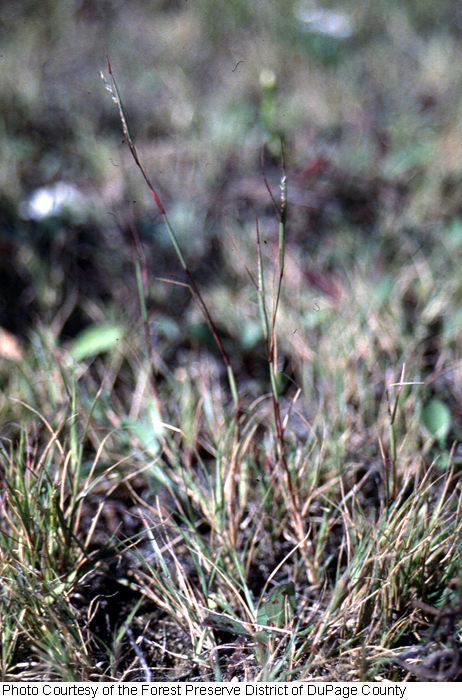|
|
|
|
Family: Poaceae
Ozark dropseed, more...puffsheath dropseed
[Sporobolus neglectus var. ozarkanus (Fernald) Steyerm. & C.L.Kucera, moreSporobolus ozarkanus Fernald, Sporobolus vaginiflorus var. neglectus (Nash) Scribn., Sporobolus vaginiflorus var. ozarkanus (Fernald) Shinners] |
Sheath bases sparsely hairy, hairs papillose-based. Spikelets 2.3-4.6 mm. Glumes usually longer than the florets; lemmas 2.1-3.9 mm, faintly 3-veined; paleas 2.1-4 mm. Fruits 1.1-2 mm. Sporobolus vaginiflorus var. ozarkanus grows primarily in the central and southeastern United States. Annual tufted herb 10 - 50 cm long Leaves: having open sheaths that are inflated and hairless except for the small tufts of hairs (to 3 mm long) at the tips. The ligules are made of hairs 0.1 - 0.3 mm long, and the blades are 1 - 12 cm long, 0.6 - 2 mm wide, flat or with margins loosely rolling toward the upper surface of the midvein (involute), with smooth to minutely rough margins, hairless lower surfaces, minutely rough upper surfaces, and (occasionally) warty-based hairs near the base. Inflorescence: terminal to axillary, branched (panicle), 2 - 5 cm long, 0.2 - 0.5 cm wide, cylindrical, with the base surrounded by the sheath. The primary branches are 0.4 - 1.8 cm long, appressed, and bear spikelets to the base. Fruit: a transluscent light brownish to orangish-brown caryopsis, 1.2 - 1.8 mm long, inversely egg-shaped, flattened laterally, with fine longitudinal lines. Culm: 10 - 45 cm long, erect to decumbent, thin but stiff, hairless. Spikelets: 1.6 - 3 mm long, yellowish to cream, sometimes with a purple tinge, borne on an appressed stalk 0.1 - 2.5 mm long and minutely rough. Glumes: nearly equal, lance-shaped to egg-shaped, membranous to thin but firm (chartaceous), hairless. The lower glume is 1.5 - 2.4 mm long, usually with a greenish midvein, and the upper glume is 1.7 - 2.7 mm long. Florets: usually one per spikelet, with three purplish anthers 1.1 - 1.6 mm long. Lemma: 1.6 - 2.9 mm long, egg-shaped with a pointed tip, thin but firm (chartaceous), hairless. Palea: 1.6 - 3 mm long, egg-shaped, thin but firm (chartaceous), hairless, two-veined, often splitting between the veins when mature. Similar species: Sporobolus vaginiflorus has sheaths that are sparsely hairy near the base, longer spikelets (2.3 - 6 mm), and lemmas with longitudinal lines. The other species of Sporobolus in the Chicago Region are perennials lacking inflated sheaths. Flowering: September Habitat and ecology: Compacted soils along road shoulders and railroad ballast. Occurence in the Chicago region: native Etymology: Sporobolus comes from the Greek words sporos, meaning seed, and ballein, meaning "to cast forth." Neglectus means overlooked. Author: The Morton Arboretum Much like no. 11 [Sporobolus vaginiflorus (A. Gray) A. W. Wood]; lower sheaths generally glabrous; panicle rarely exsert, usually surpassed by the uppermost blade; spikelets smaller, the glumes and lemmas less acuminate and proportionately wider; first glume 1.5-2.4 mm, the second 1.7-2.7 mm; lemma 1-nerved, 1.5-3 mm, glabrous, about equaling the wide, acute, split palea; grain falling free at maturity, and freeing the seed when moistened; 2n=36. Dry sterile or sandy soil; Me. and s. Que. to N.D., s. to N.J., Tenn., La., and Tex.; also Wash. and Ariz. Gleason, Henry A. & Cronquist, Arthur J. 1991. Manual of vascular plants of northeastern United States and adjacent Canada. lxxv + 910 pp. ©The New York Botanical Garden. All rights reserved. Used by permission. |



